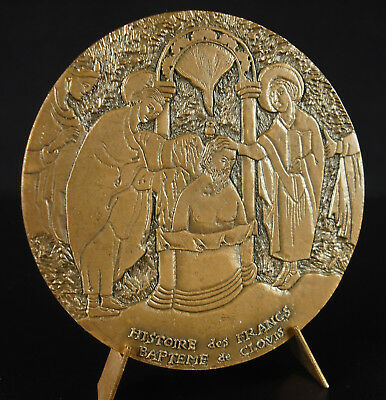-40%
Medal Saint Gregoire Magic Tricks Georgius Florentius Gregorius Clovis The
$ 78.75
- Description
- Size Guide
Description
54-Med 18Bronze medal from the Monnaie de Paris (Cornucopia hallmark from 1880)
Struck in 1973.
Some traces of oxidation to report.
Engraver / Artist
: Alain Paoli
.
Dimensions
: 72 mm.
Weight
:
194 g
.
Metal
: bronze
.
Hallmark on the edge:
cornucopia + bronze + 1973.
Quick and neat delivery.
The stand is
not
for sale.
Support is not for sale.
Grégoire de Tours, or Georgius Florentius Gregorius, born in the city of Arvernes1 in 5382 or 5393,4 in Clermont-Ferrand or Riom5 and died on November 17, 594 in Tours, is bishop of Tours, historian of the Church and of the Franks with his History of the Franks.
A Gallo-Roman aristocrat
He comes, through his father Florent (Florentius), from an aristocratic Arverne family: his father and his maternal great-grandfather Grégoire Georgius (or Georgins), former bishop of Langres3, had been senators, and his paternal uncle was Gallus or Saint Gal I, bishop of Clermont 3. Through his mother Armentaria, he is related to the bishops of Lyon Sacerdos and Saint Nizier on the one hand, and to the bishops of Langres, Tetricus, and great-grandson of Grégoire de Langres on the other. It is also from Grégoire de Langres that he takes his third name, the one by which he is known. Prestige therefore comes from two facts, one by
Grégoire de Tours, or Georgius Florentius Gregorius, born in the city of Arvernes1 in 5382 or 5393,4 in Clermont-Ferrand or Riom5 and died on November 17, 594 in Tours, is bishop of Tours, historian of the Church and of the Franks with his History of the Franks. He comes, through his father Florent (Florentius), from an aristocratic Arverne family: his father and his maternal great-grandfather Grégoire Georgius (or Georgins), former bishop of Langres3, had been senators, and his paternal uncle was Gallus or Saint Gal I, bishop of Clermont 3. Through his mother Armentaria, he is related to the bishops of Lyon Sacerdos and Saint Nizier on the one hand, and to the bishops of Langres, Tetricus, and great-grandson of Grégoire de Langres on the other. It is also from Grégoire de Langres that he












